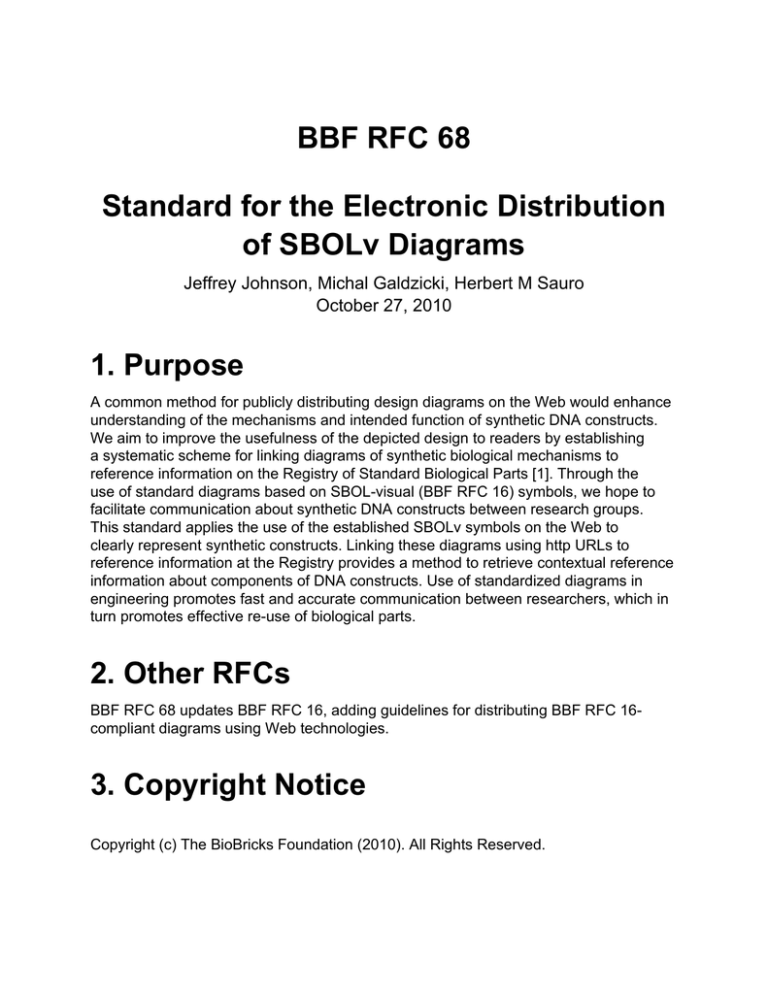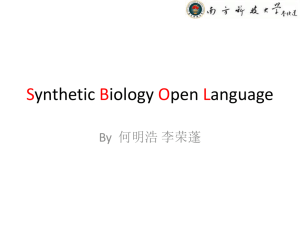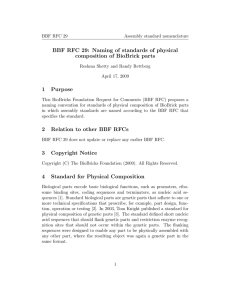BBF RFC 68 Standard for the Electronic Distribution of SBOLv Diagrams 1. Purpose
advertisement

BBF RFC 68 Standard for the Electronic Distribution of SBOLv Diagrams Jeffrey Johnson, Michal Galdzicki, Herbert M Sauro October 27, 2010 1. Purpose A common method for publicly distributing design diagrams on the Web would enhance understanding of the mechanisms and intended function of synthetic DNA constructs. We aim to improve the usefulness of the depicted design to readers by establishing a systematic scheme for linking diagrams of synthetic biological mechanisms to reference information on the Registry of Standard Biological Parts [1]. Through the use of standard diagrams based on SBOL-visual (BBF RFC 16) symbols, we hope to facilitate communication about synthetic DNA constructs between research groups. This standard applies the use of the established SBOLv symbols on the Web to clearly represent synthetic constructs. Linking these diagrams using http URLs to reference information at the Registry provides a method to retrieve contextual reference information about components of DNA constructs. Use of standardized diagrams in engineering promotes fast and accurate communication between researchers, which in turn promotes effective re-use of biological parts. 2. Other RFCs BBF RFC 68 updates BBF RFC 16, adding guidelines for distributing BBF RFC 16compliant diagrams using Web technologies. 3. Copyright Notice Copyright (c) The BioBricks Foundation (2010). All Rights Reserved. 4. Table of Contents 1. Purpose 2. Other RFCs 3. Copyright Notice 4. Table of Contents 5. Background 6. Description of the Standard 6.1. Use of SBOLv 6.2 Creating Labels 6.3 HTTP URL linking 7. Implementing an HTML Imagemap 7.1 TinkerCell - Synthetic Biology CAD 7.2 WikiDust - BBF RFC 68 Compliant Tool 8. Authors 9. Acknowledgements 10. References Appendix A 5. Background Standard, unambiguous diagrams are central to communication in many established fields of engineering, but have not yet been widely adopted by synthetic biologists. Diagrams depicting DNA constructs and the biological processes in which they participate are critical to understanding the mechanisms by which synthetic systems work. Such diagrams communicate information about synthetic biology designs. Currently, most synthetic biologists invent their own illustrations on a case by case basis. The traditional methodology, in which a research laboratory studying a system in detail forms its own conventions for graphic depictions, hinders dissemination of the designs and their explanations to other biological engineers. SBOL-visual (BBF RFC 16) provides a set of standard glyphs that can be used to represent synthetic DNA constructs. It is the graphical notation component of the Synthetic Biology Open Language (SBOL) [2] being developed by the Synthetic Biology Data Exchange Group as an open standard which anyone can use freely or contribute to. This formal specification for composite part designs made by biological engineers using rational design based engineering methods, represents many of the common concepts describing DNA construct features. For example there are glyphs for basic parts, which play a role in the central dogma, such as the origin of replication, forward constitutive promoter, and the forward open reading frame. It also provides the visual vocabulary for DNA features of interest in genetic engineering, such as a forward primer site and a 3' overhang restriction site. No glyphs are currently available for devices as part of SBOLv, although some have been proposed in BioBrick Graphical Language (BBF RFC 18). The systems biology community has proposed the use of Systems Biology Graphical Notation (SBGN) a visual notation for network diagrams in biology [3]. This project defines a standard for the graphical notation used in maps of biochemical and cellular processes. It is a robust effort to define a systematic visual language for biological processes, but fails to make a recommendation for the concurrent representation of DNA constructs and their associated processes. The developments of SBGN should be closely monitored and adopted for synthetic biology standards when appropriate. However, it has goals distinct from the purpose of engineering and significant differences from common practices in synthetic biology. Through BBF RFC 68, we extend the SBOLv standard (BBF RFC 16) to specify how diagrams composed of the standard glyphs should be displayed and shared on web pages. Adherence to a common online diagram format will help researchers communicate the mechanisms by which their devices work as simply and unambiguously as possible. The goal is to improve synthetic biologists’ capability to quickly browse through available example parts and systems. More productive research will promote successful re-use of existing parts, as well as successful construction of new parts. 6. Description of the Standard Distribution of a standardized diagrams describing DNA construct designs for synthetic biology depends both on the use of a standard set of symbols and on the method of distribution. Therefore the two main requirements for BBF RFC 68 are: 1. The use of SBOLv symbols 2. The linking of symbols to reference entry pages on the Registry of Standard Biological Parts using http URLs Essentially creating a systematically annotated image, using the <imagemap> HTML tag. The result constitutes a diagram which allows the reader to click on portions of the diagram which correspond to SBOLv symbols and read the reference information about that particular portion of the diagram. 6.1. Use of SBOLv To comply with BBF RFC 68, diagrams MUST use the symbols described in BBF RFC 16 to represent DNA constructs. These symbols represent a great variety of construct components. For example, there are symbols for different promoter sequence types, a ribosome binding site, open reading frame, and transcriptional terminator sequences. Therefore, use of these symbols allows the representation of common construct types such as an expression cassette (Figure 1). It is also possible to represent more complex constructs (Appendix A). Figure 1. This diagram of an example GFP expression cassette construct uses SBOLv symbols. A constitutive promoter (J23100), a ribosome binding site sequence (B0034), the GFP open reading frame (E0040), and a commonly used transcriptional terminator (B0015). Another symbol MAY be used if there is no appropriate symbol in BBF RFC 16. For example, there are many possible representations of a protein, and several might be used to distinguish between different species in the same diagram. If such new symbols are necessary the symbols adopted SHOULD be consistent between related diagrams within a description of a project and MAY be submitted as proposed extensions of SBOLv (sbolstandard.org/sbol-visual). To improve the clarity of the intended meaning, contiguous pieces of DNA MUST be indicated by connecting the line through adjacent symbols, and separate pieces of DNA MUST be indicated with separate lines. When diagrams include composite parts, those parts MAY be represented at various scales as a single glyph. If the individual components of a composite part are shown, the composite part SHOULD additionally be indicated by using an outline border, an appropriate label, and/or matching colors. 6.2 Creating Labels Constructs represented using SBOLv glyphs in diagrams conforming to BBF RFC 68 MUST be labeled, and the choice of label text SHOULD be prioritized as follows: 1. MUST use a name meaningful within the context of the diagram. For example, when describing a GFP expression cassette it is critical to indicate which component is the coding sequence for the GFP protein (Figure 1). 2. MAY use a name established by precedent in the literature. 3. MAY use a meaningful shorthand, such as the BioBrick nickname. 4. MAY use a unique identifier, such as the BioBrick name. 6.3 HTTP URL linking Wherever an SBOLv glyph is used to represent a construct, the symbol MUST be referenced via an http URL [4] to a corresponding Part entry page on the Registry of Standard Biological Parts. Simply, use a web link the Registry for the sub-part or construct which is represented by each symbol in the diagram. Therefore, all DNA constructs represented in BBF RFC 68 (this RFC) compliant diagrams as SBOLv symbols MUST be submitted to the Registry. Non-public construct information may be referenced to internal URLs, but MUST be updated prior to open publication to comply with this standard. Diagrams MUST be constructed and distributed such that clicking an SBOLv symbol in a web browser retrieves the associated Registry page. For example, a compliant diagram can be implementing as an HTML imagemap (see Section 7.) within a webpage hosted on web server. Alternatively, these can be implemented as a set of individual glyph images properly aligned using various HTML layout options and linked using a simple web link surrounding each image, like so: <a href=”URL1”> <image src=”imagefile1”> </a> There are likely many specific options for linking images using the standard http URL web protocol. Diagrams SHALL NOT be included as part of larger, non-interactive figures, or distributed in any form that prevents the user from accessing the referenced pages. 7. Implementing an HTML Imagemap We RECOMMEND that interactive diagrams be implemented as image-maps. These MAY be written in HTML or wiki markup, depending the technical requirements of the target website. For example, regular HTML can be used to place a simple diagram on a standard webpage (Figure 2). To indicate the target of the link and clarify the specific part identifier, a mouse-over title MUST indicate the BioBrick name of their associated entity (Figure 2.a). a b <img src="http://sbolstandard.org/images/plux.jpg" width="229" height="157" usemap="#map1"/> <map name="map1"> <area shape="rect" coords="66,21,166,91" title="BBa_R0062" href="http://partsregistry.org/Part:BBa_R0062"/> </map> c <imagemap> Image:pLux.jpg|229px rect 66 21 166 91 [http://partsregistry.org/Part:BBa_R0062 BBa_R0062] </imagemap> Figure 2. Example implementation of diagram links. a. An image showing what a diagram of a single SBOLv glyph for a forward inducible promoter, pLux, displaying a mouse-over BioBrick Part name. b. Example HTML code for an image map which links a diagram to the Standard Parts Registry page entry for BBa_R0062 which corresponds to pLux. c. Exmple MediaWiki extension code for an image map to perform the same function within MediaWiki pages. The example HTML code provided in Figure 2.b will work anywhere HTML is expected, for example, the iGEM.org wiki [5], OpenWetWare [6], from any website which answers HTTP requests and should render appropriately in web browsers that interpret HTML. For a complete example of a DNA construct created and documented using this standard, see Appendix A. Since the map coordinates must match specific points on the source image, however, the diagram image cannot easily be re-sized. To overcome this limitation, an equivalent imagemap written in MediaWiki markup [7] MAY be used (Figure 2.c). MediaWiki markup imagemaps are simpler and more robust than their HTML counterparts because their coordinates refer to positions on the fullsize image from the image file page (Image:pLux.jpg in this case), rather than the smaller version displayed. This means the map can be re-sized by changing the width or height, and the coordinates will still be correct. However, these maps only work on MediaWiki sites with the Imagemap extension [8] installed. 7.1 TinkerCell - Synthetic Biology CAD TinkerCell is a computer-aided design tool for synthetic biology [9]. It provides a toolkit of molecules, biological parts, and cellular compartments. By inserting reactions between them and changing parameters like concentration, half life, and activity, these items can be used to build quantitative models of biological systems. Simulations can then be run to predict their behavior under different conditions. Because TinkerCell uses SBOLv glyphs to represent biological parts, these models can also be made into diagrams compatible with BBF RFC 68. In fact, all the diagrams in this RFC were created using TinkerCell. TinkerCell diagrams are visually clean and relatively intuitive to understand. They use common conventions and allow a great deal of flexibility of visual manipulation, while still offering facilitated layout features like alignment and grouping. TinkerCell’s symbol-based authoring environment can be extended with custom icon sets, called themes, to address different visual needs—including creation of SBOLv compliant diagrams. 7.2 WikiDust - BBF RFC 68 Compliant Tool Because TinkerCell can rapidly generate high-quality diagrams that are useful for communicating information about synthetic constructs, the Washington 2010 iGEM team has written a plugin specifically designed to create imagemaps from TinkerCell models and publish them to websites. This plugin, called WikiDust [10], searches a semantic knowledgebase for information about synthetic biological parts, including those from the Parts Registry. It adds BioBrick Name and/or URI attributes to TinkerCell items; these attributes are then used to generate HTML or MediaWiki markup code for an imagemap. WikiDust automatically handles uploading HTML imagemaps to iGEM.org pages. Alternatively, the imagemap code, along with an image, can simply be displayed for users to copy and paste into another website. It is hoped that these tools will simplify the process of creating and publishing a BBF RFC 68-compliant diagram. However, using them is entirely OPTIONAL. 8. Authors Jeffrey Johnson: Michal Galdzicki: Herbert Sauro: jeff3@uw.edu mgaldzic@uw.edu hsauro@uw.edu 9. Acknowledgements We would like to thank: Deepak Chandran for his help with the TinkerCell API and unwavering encouragement. Matthew Coyne for testing WikiDust and providing feedback and bug reports. Matthew Harger for his helpful comments in preparation of this BBF RFC document. The rest of the members of the University of Washington 2010 iGEM team for their feedback on use of SBOLv symbols. 10. References [1] “Registry of Standard Biological Parts.” [Online]. Available: http://partsregistry.org/ Main_Page. [Accessed: 26-Oct-2010]. [2] “SBOL standard.” [Online]. Available: http://www.sbolstandard.org/. [Accessed: 26-Oct2010]. [3] N. L. Novere et al., “The Systems Biology Graphical Notation,” Nat Biotech, vol. 27, no. 8, pp. 735-741, 2009. [4] R. Fielding et al., “Hypertext Transfer Protocol -- HTTP/1.1,” Network Working Group Request for Comments: 2616. Available: http://www.ietf.org/rfc/rfc2616.txt [5] “International Genetically Engineered Machine competition (iGEM).” [Online]. Available: http://2010.igem.org/Main_Page. [Accessed: 26-Oct-2010]. [6] “OpenWetWare.” [Online]. Available: http://openwetware.org/wiki/Main_Page. [Accessed: 26-Oct-2010]. [7] “MediaWiki.” [Online]. Available: http://www.mediawiki.org/wiki/MediaWiki. [Accessed: 26Oct-2010]. [8] “Extension:ImageMap - MediaWiki.” [Online]. Available: http://www.mediawiki.org/wiki/ Extension:ImageMap. [Accessed: 26-Oct-2010]. [9] D. Chandran, F. Bergmann, and H. Sauro, “TinkerCell: modular CAD tool for synthetic biology,” Journal of Biological Engineering, vol. 3, no. 1, p. 19, 2009. [10] “WikiDust - a TinkerCell plugin.” [Online]. Available: http://2010.igem.org/ Team:Washington/Tools_Created/New_Software. [Accessed: 26-Oct-2010]. Appendix A a b <img src="http://2010.igem.org/wiki/images/a/af/Washington_F2620.png" width="500" height="272" usemap="#Washington_F2620"/> <map name="Washington_F2620"> <area shape="rect" coords="231,182,296,228" title="BBa_B0010" href="http://partsregistry.org/Part:BBa_B0010"/> <area shape="rect" coords="296,182,361,228" title="BBa_B0012" href="http://partsregistry.org/Part:BBa_B0012"/> <area shape="rect" coords="74,210,126,228" title="BBa_B0034" href="http://partsregistry.org/Part:BBa_B0034"/> <area shape="rect" coords="426,210,478,228" title="BBa_B0034" href="http://partsregistry.org/Part:BBa_B0034"/> <area shape="rect" coords="126,210,231,228" title="BBa_C0062" href="http://partsregistry.org/Part:BBa_C0062"/> <area shape="rect" coords="361,182,426,228" title="BBa_R0062" href="http://partsregistry.org/Part:BBa_R0062"/> <area shape="rect" coords="274,90,335,148" title="BBa_R0062" href="http://partsregistry.org/Part:BBa_R0062"/> <area shape="rect" coords="9,182,74,228" title="BBa_R0040" href="http://partsregistry.org/Part:BBa_R0040"/> </map> a. Example of a typical diagram created in TinkerCell and uploaded as an HTML imagemap using WikiDust. b. The HTML code is similar to previous examples, except that some items (3OC6HSL and LuxR) are not mentioned. Although SBOLv symbols MUST link to pages on the Registry, other symbols MAY link to other websites, or MAY not contain links at all.







